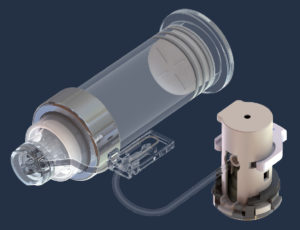Citation: Devitt S, “Extending Container Closure Integrity to Wearable Injectors”. ONdrugDelivery, Issue 124 (Sep 2021), pp 32–34.
Shaun Devitt looks at how the principles and methods of container closure integrity might be adapted for wearable injectors.
For many in the drug delivery and pharmaceutical industry, container closure integrity (CCI) is understood to be a major – even foundational – element of product quality. For newcomers and innovators, its scope and achievement can be a mystery. As we move into a new paradigm of complexity and capability with wearable injectors, how will the principles and methods of CCI be adapted and incorporated to enable a new generation of therapies?
CCI: A KEYSTONE ASPECT
To develop a systematic understanding of CCI, it is best to start with a definition. From the US Pharmacopeia (USP) Chapter 1207, “Container closure integrity is the ability of a package to prevent product loss, to block micro-organism ingress, and to limit entry of detrimental gasses or other substances”.1 To break that down further, CCI is a characteristic of a container regarding its function of containing and protecting the product it holds. Of note, the requirements expected of the container are driven by the product and what is a detrimental level of product loss or product exposure for that specific application.
Therefore, no container can universally “meet CCI” without a product context and, indeed, some container formats are fundamentally incapable of meeting particularly stringent product needs.
Furthermore, these requirements defining CCI draw from the full span of quality attributes, embodying both product safety (block microorganism ingress) and efficacy (prevent product loss and limit entry of detrimental substances). When expressed in this fashion, the rationale for CCI to have high and ever-growing importance for both manufacturers and regulators becomes self-evident.
CCI AND TRADITIONAL CONTAINER FORMATS
Maximising container integrity at all costs is not without its drawbacks, however. An idealised “perfectly integral” container subsequently has the functional issue of ease of access to the product. Consequently, the industry has actually moved away from the ideal over time to provide more usable and accessible modes of delivery. This progression of products is depicted in Figure 1.

Figure 1: Trajectory of traditional drug containers – ampoules, vials and syringes – sustaining CCI, improving usability.
What could be a more ideal container closure than a single-component glass ampoule? And yet, the only way to access the drug is to snap off the glass cap, with the risk of introducing glass particles and thus possibly compromising safety or efficacy. While ampoules retain their place in many applications, vials and, more recently, syringes have come to dominate new product containment.
Now multiple components create the container, with increased potential for ingress at the sealing interface. In the case of syringes, there are also multiple locations of ingress as well as a dynamic (sliding) seal. With each step of increasing complexity, the requirement for maintaining CCI does not change, but the demonstration of its fulfilment (both in development and in routine manufacturing) becomes more extensive. This has included the CCI testing of seals at the edges of specification for dimensions as well as environmental conditions (such as storage of vials under cryogenic temperatures for some covid-19 vaccines). And since CCI is defined by the drug product and not the container, evaluations and verifications for these well-established formats are still ongoing as new products with greater needs are developed.
“Leak test methods should be selected based on an appropriate sensitivity and means of challenge relative to the requirements.”
CCI TEST METHODS
How then is CCI measured or verified through testing? Many test methods have been developed to meet the needs of the wide range of container formats and integrity requirements now present. All containers leak at some level, but the purpose of an integrity test is to discern if a leak rate can occur that would violate the CCI requirements of a particular product. So the leak test methods should be selected based on an appropriate sensitivity and means of challenge relative to the requirements.
Many guidance documents have now been produced describing the available methods and their suitable applications, such as USP <1207>.1 Traditionally, the focus was on directly proving that the container was blocking microorganism ingress, with the test approach being microbial exposure through forced air or liquid exposure followed by a sterility test. Subsequently, testing has moved to physical leak tests, such as vacuum decay or mass extraction, which can give the same assurance faster and with greater repeatability and reproducibility.
But, in many cases, the product requirements for limiting entry of detrimental substances can result in different or stricter criteria for test methods. In these cases (for example, oxygen-sensitive products) other test methods such as tracer gas detection or laser headspace analysis must be employed. Through the accounting of the full scope of CCI, it is atypical that any single test method will be sufficient for a combination product. So the objective in selection should be method suitability for a requirement rather than a universal “best” CCI test method.
“CCI is not about containers at all: it is about patients and products, and what is necessary to ensure their successful interaction.”
WEARABLE INJECTORS: A MENAGERIE OF CONTAINERS
Wearable injectors represent a large part of the next generation of drug delivery devices after syringes/cartridges and the devices that use them (such as autoinjectors and pen injectors). They promise a new degree of accessibility and usability, delivering larger volumes over longer durations and even controlling the time of start and finish – and possibly even communicating all this back to a monitoring system.
To achieve these varied aims, manufacturers have elected a wide range of container sizes, materials and formats. The sheer variety can be seen through a quick perusal of this very edition of ONdrugDelivery. Some wearable injector systems are based around traditional containers such as vials and cartridges. Some use elements of syringes or syringe components. Others seek inspiration from large-volume parenteral containers such as IV bags, form/fill/seal packages or other flexible pouches. And others still have elected entirely novel packaging and sealing constructions – or at least novel for drug delivery systems.

Figure 2: An example of a wearable injector container and fluid path assembly.
Just like in the expansion to prefilled syringes, these new containers will have to demonstrate fulfilment of CCI even as that requires significant alteration or extension of the established test methods. Even where the primary containers have hewed closely to established container forms, such as the cartridge shown in Figure 2, the additional functionality of the wearable injector system can create new requirements for evaluation.
Like many other wearable injectors, the system shown in Figure 2 has a fluid path assembly between the container and the patient needle. This new assembly is not the primary container (as drug is not stored long term within it) but it is still, however briefly, a drug container; certainly, the element of CCI for “preventing product loss” must apply to the fluid path. Thus, wearable injectors are bringing not only forms of containers to combination products but also new dimensions of the extent of the container system.
WEARABLE CCI: SAME PRINCIPLES, MORE CONSIDERATIONS
“Many wearable injectors introduce new subassemblies
that qualify as containers even if they are not primary containers.”
While the novelty of most implementations of wearable injector containers has been noted, this does not portend a massive revolution in CCI standards or testing methodologies. While many test methods will need to be revised or extended to accommodate new geometries and materials, the core test principles (whether vacuum decay, laser headspace, dye penetration, etc) will retain their particular effectiveness. As containers get larger, there will be a shift in the test sensitivity, with some methods affected more than others. In some cases, where the container is particularly novel, the specific deterministic test methods now in force for standard containers may not readily apply.
For example, some materials of construction may have outgassing or permeation characteristics that incorrectly impute leaks in tracer gas or vacuum decay tests. Or extreme aspect ratios or container mechanical properties may prohibit adequate repeatability and reliability at the necessary sensitivity. In these cases, the fallback remains of “direct proofs” of CCI through microbial challenge and liquid dye immersion. However, in these cases, a container redesign should be strongly considered, since these test methods have known limitations, and this is quite possibly just one of several areas where product design, however elegant, is inhibiting quality assurance and quality control.
However, the most significant area of change is the further multiplication of considerations to be accounted for in a holistic reckoning of CCI. Many wearable injectors introduce new sub-assemblies that qualify as containers even if they are not primary containers. Depending on the conditions and duration of use, these subassemblies may need to meet requirements for not only product loss but also microbial ingress and contaminant ingress.
Wearable injectors can also be exposed to a wider range of environmental exposures up to and through end of use, including potentially long periods of on-body wear. Wherever feasible, suitable simulated use testing can demonstrate CCI while mitigating the testing burden. In every case, it is critical to manage each element of CCI separately so that the aims are met for the new system without adding undue burden.
CONCLUSION
CCI is a foundational aspect of combination products that impacts assurance of both product safety and efficacy. Over decades, many tests have been developed for the various parenteral containers today – there is no “best test” or one-size-fits all solution. As wearable injectors expand drug delivery therapies, they bring new dimensions to this established field: modified test methods, new classification of containers and more complicated conditions for CCI assurance. This greater sophistication in container requirements only highlights the irony that CCI is not about containers at all: it is about patients and products, and what is necessary to ensure their successful interaction. Wearable injectors are poised to offer new levels of functionality, usability and patient outcomes to make this extension of testing and assurance more than worthwhile.
REFERENCES
- “USP <1207> Package Integrity Evaluation: Sterile Products”. US Pharmacopeial Convention, 2018.

